Report: Diversity and Diversity Management in the Workplace
VerifiedAdded on 2021/04/21
|13
|2746
|73
Report
AI Summary
This report examines diversity and diversity management within the context of globalization. It begins with a background on the evolution of diversity programs, moving from early efforts focused on race and gender to a broader understanding of individual and group differences. The report poses research questions regarding the conceptualization of diversity and the driving forces behind diversity management in the workplace. It reviews relevant literature, defining diversity management and tracing its historical development, from early affirmative action initiatives to more comprehensive diversity management models. The methodology section outlines a mixed-methods approach, incorporating both quantitative and qualitative data collection through questionnaires and interviews. Ethical considerations, including data accessibility and participant consent, are also addressed. The report aims to provide a detailed analysis of diversity management in global firms, offering insights into its complexities and implications.
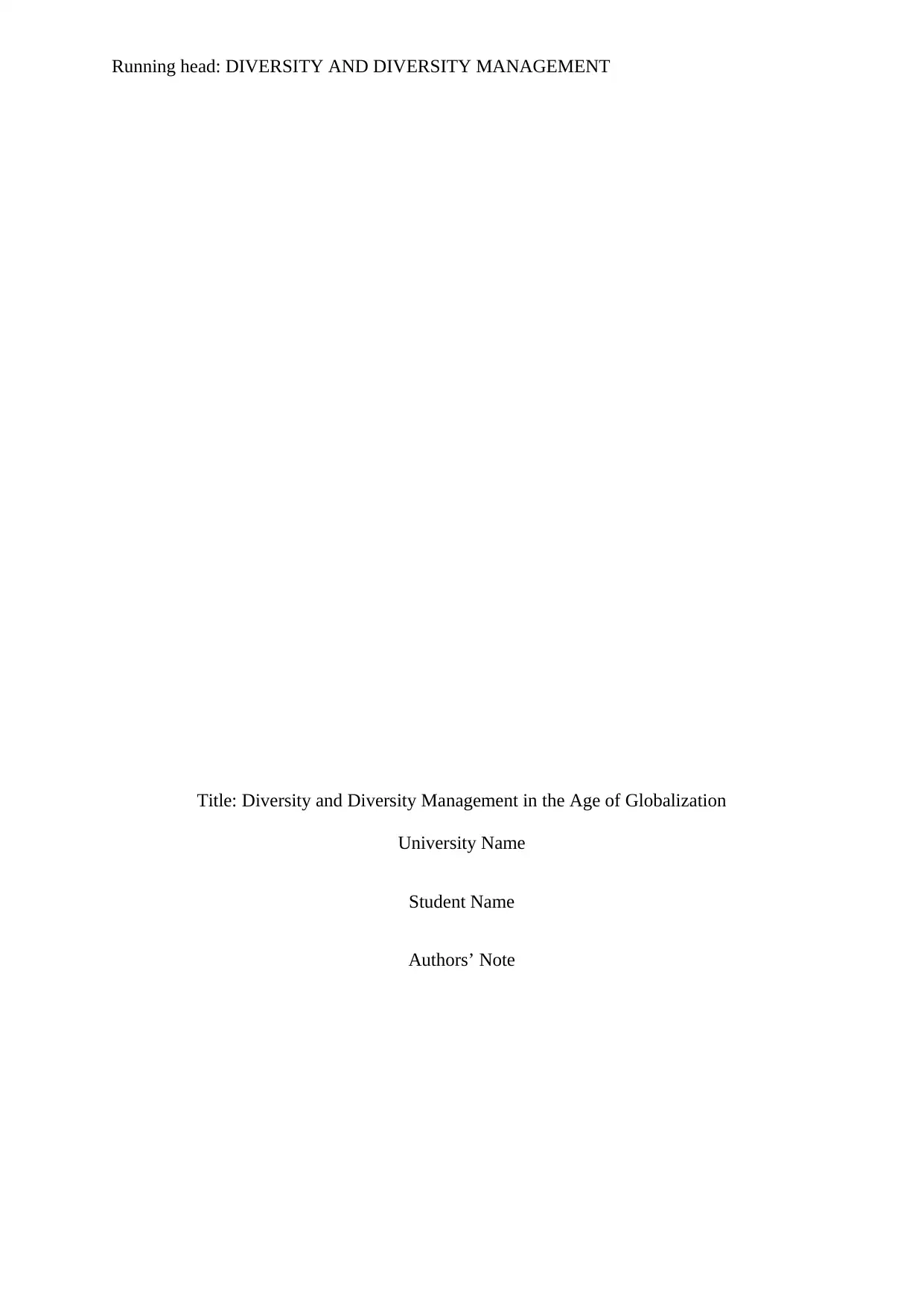
Running head: DIVERSITY AND DIVERSITY MANAGEMENT
Title: Diversity and Diversity Management in the Age of Globalization
University Name
Student Name
Authors’ Note
Title: Diversity and Diversity Management in the Age of Globalization
University Name
Student Name
Authors’ Note
Paraphrase This Document
Need a fresh take? Get an instant paraphrase of this document with our AI Paraphraser
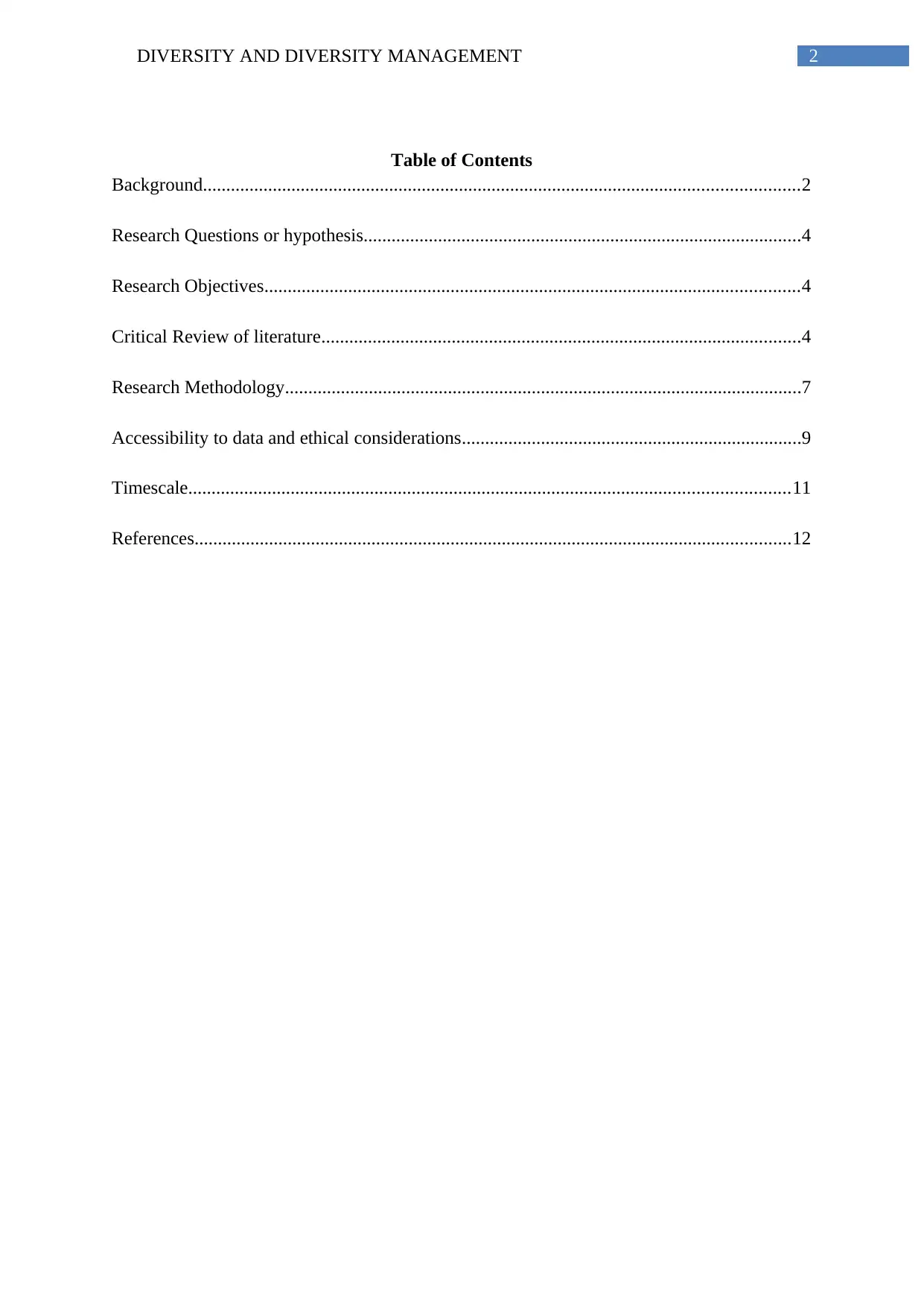
2DIVERSITY AND DIVERSITY MANAGEMENT
Table of Contents
Background................................................................................................................................2
Research Questions or hypothesis..............................................................................................4
Research Objectives...................................................................................................................4
Critical Review of literature.......................................................................................................4
Research Methodology...............................................................................................................7
Accessibility to data and ethical considerations.........................................................................9
Timescale.................................................................................................................................11
References................................................................................................................................12
Table of Contents
Background................................................................................................................................2
Research Questions or hypothesis..............................................................................................4
Research Objectives...................................................................................................................4
Critical Review of literature.......................................................................................................4
Research Methodology...............................................................................................................7
Accessibility to data and ethical considerations.........................................................................9
Timescale.................................................................................................................................11
References................................................................................................................................12
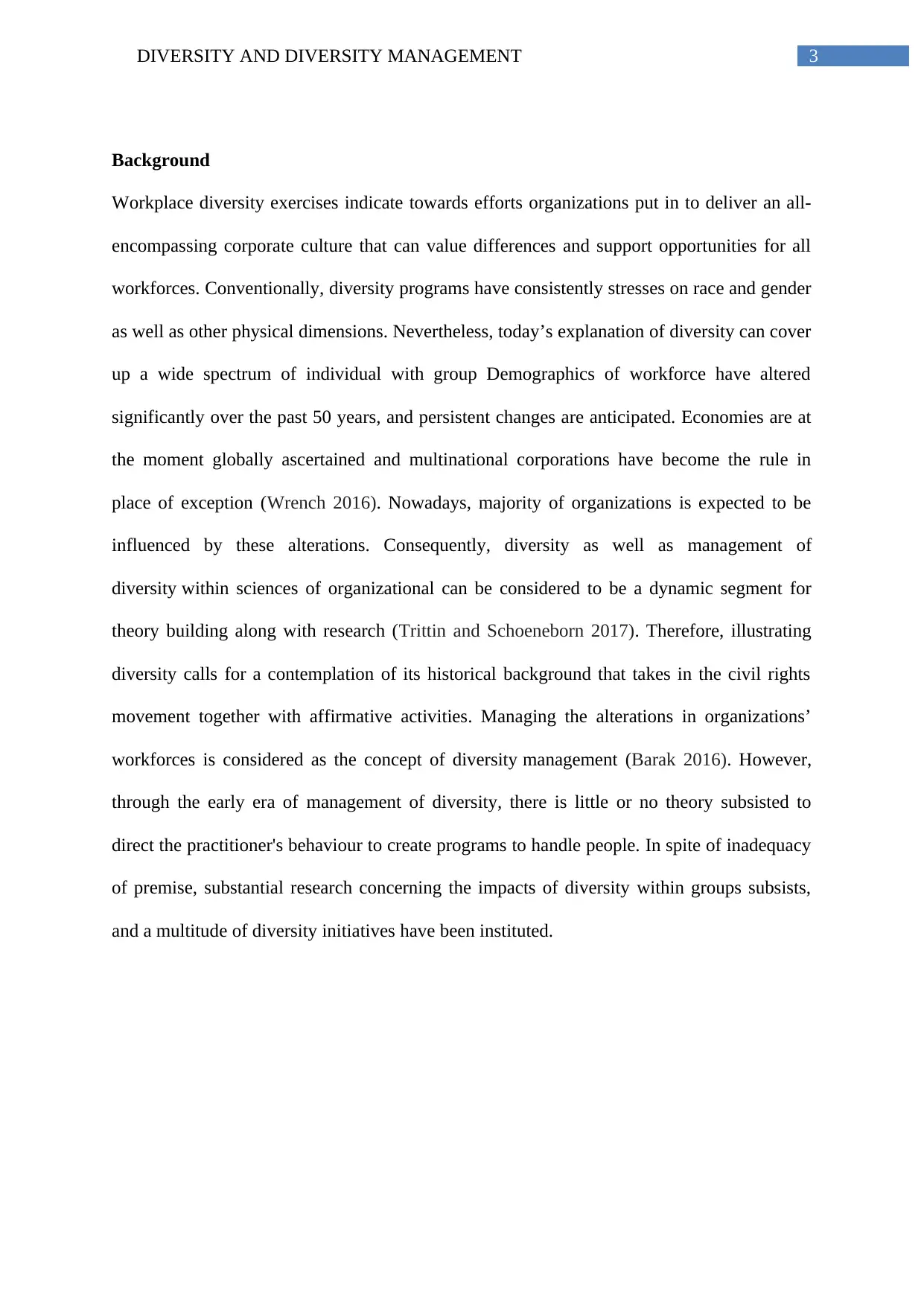
3DIVERSITY AND DIVERSITY MANAGEMENT
Background
Workplace diversity exercises indicate towards efforts organizations put in to deliver an all-
encompassing corporate culture that can value differences and support opportunities for all
workforces. Conventionally, diversity programs have consistently stresses on race and gender
as well as other physical dimensions. Nevertheless, today’s explanation of diversity can cover
up a wide spectrum of individual with group Demographics of workforce have altered
significantly over the past 50 years, and persistent changes are anticipated. Economies are at
the moment globally ascertained and multinational corporations have become the rule in
place of exception (Wrench 2016). Nowadays, majority of organizations is expected to be
influenced by these alterations. Consequently, diversity as well as management of
diversity within sciences of organizational can be considered to be a dynamic segment for
theory building along with research (Trittin and Schoeneborn 2017). Therefore, illustrating
diversity calls for a contemplation of its historical background that takes in the civil rights
movement together with affirmative activities. Managing the alterations in organizations’
workforces is considered as the concept of diversity management (Barak 2016). However,
through the early era of management of diversity, there is little or no theory subsisted to
direct the practitioner's behaviour to create programs to handle people. In spite of inadequacy
of premise, substantial research concerning the impacts of diversity within groups subsists,
and a multitude of diversity initiatives have been instituted.
Background
Workplace diversity exercises indicate towards efforts organizations put in to deliver an all-
encompassing corporate culture that can value differences and support opportunities for all
workforces. Conventionally, diversity programs have consistently stresses on race and gender
as well as other physical dimensions. Nevertheless, today’s explanation of diversity can cover
up a wide spectrum of individual with group Demographics of workforce have altered
significantly over the past 50 years, and persistent changes are anticipated. Economies are at
the moment globally ascertained and multinational corporations have become the rule in
place of exception (Wrench 2016). Nowadays, majority of organizations is expected to be
influenced by these alterations. Consequently, diversity as well as management of
diversity within sciences of organizational can be considered to be a dynamic segment for
theory building along with research (Trittin and Schoeneborn 2017). Therefore, illustrating
diversity calls for a contemplation of its historical background that takes in the civil rights
movement together with affirmative activities. Managing the alterations in organizations’
workforces is considered as the concept of diversity management (Barak 2016). However,
through the early era of management of diversity, there is little or no theory subsisted to
direct the practitioner's behaviour to create programs to handle people. In spite of inadequacy
of premise, substantial research concerning the impacts of diversity within groups subsists,
and a multitude of diversity initiatives have been instituted.
⊘ This is a preview!⊘
Do you want full access?
Subscribe today to unlock all pages.

Trusted by 1+ million students worldwide
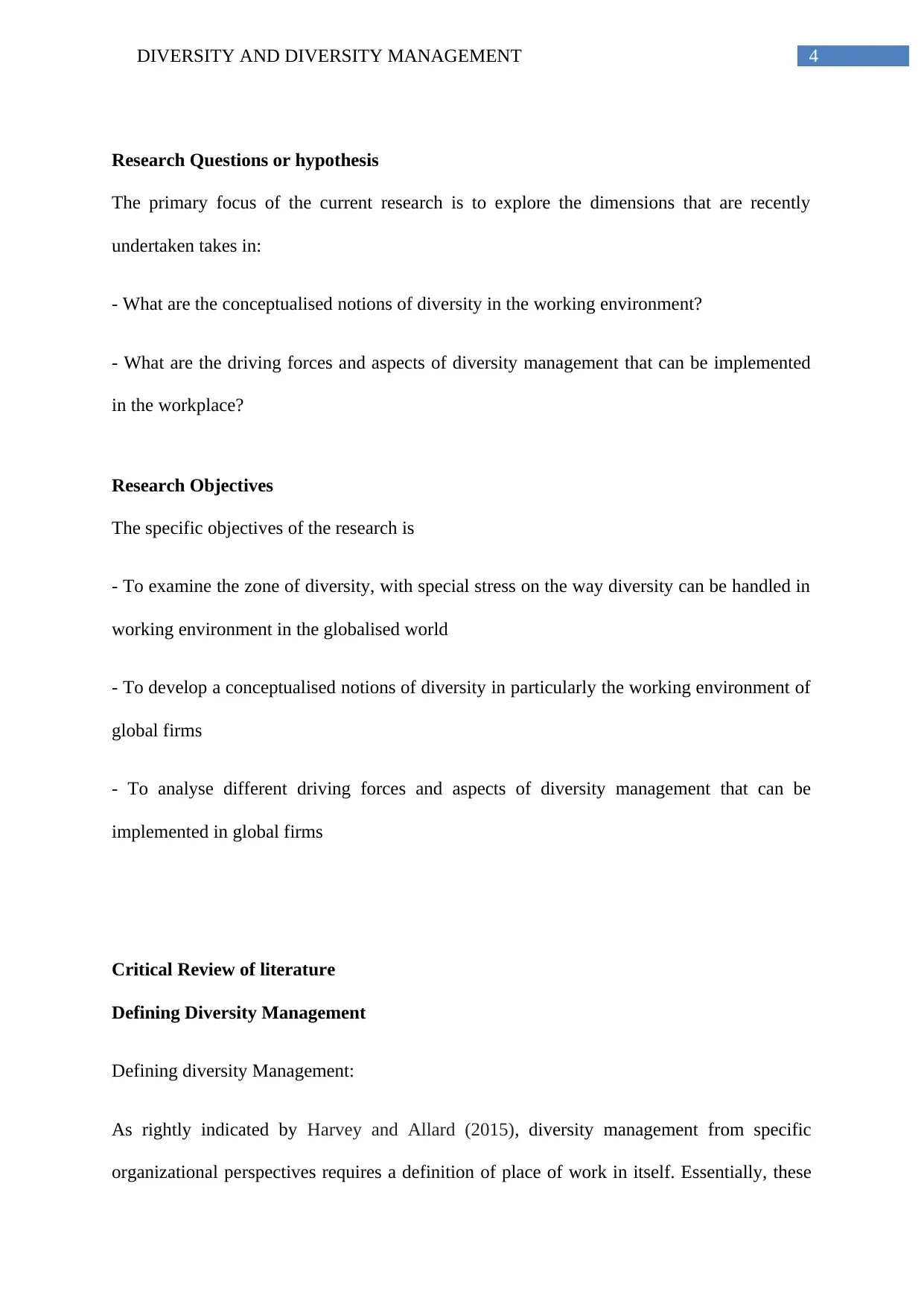
4DIVERSITY AND DIVERSITY MANAGEMENT
Research Questions or hypothesis
The primary focus of the current research is to explore the dimensions that are recently
undertaken takes in:
- What are the conceptualised notions of diversity in the working environment?
- What are the driving forces and aspects of diversity management that can be implemented
in the workplace?
Research Objectives
The specific objectives of the research is
- To examine the zone of diversity, with special stress on the way diversity can be handled in
working environment in the globalised world
- To develop a conceptualised notions of diversity in particularly the working environment of
global firms
- To analyse different driving forces and aspects of diversity management that can be
implemented in global firms
Critical Review of literature
Defining Diversity Management
Defining diversity Management:
As rightly indicated by Harvey and Allard (2015), diversity management from specific
organizational perspectives requires a definition of place of work in itself. Essentially, these
Research Questions or hypothesis
The primary focus of the current research is to explore the dimensions that are recently
undertaken takes in:
- What are the conceptualised notions of diversity in the working environment?
- What are the driving forces and aspects of diversity management that can be implemented
in the workplace?
Research Objectives
The specific objectives of the research is
- To examine the zone of diversity, with special stress on the way diversity can be handled in
working environment in the globalised world
- To develop a conceptualised notions of diversity in particularly the working environment of
global firms
- To analyse different driving forces and aspects of diversity management that can be
implemented in global firms
Critical Review of literature
Defining Diversity Management
Defining diversity Management:
As rightly indicated by Harvey and Allard (2015), diversity management from specific
organizational perspectives requires a definition of place of work in itself. Essentially, these
Paraphrase This Document
Need a fresh take? Get an instant paraphrase of this document with our AI Paraphraser
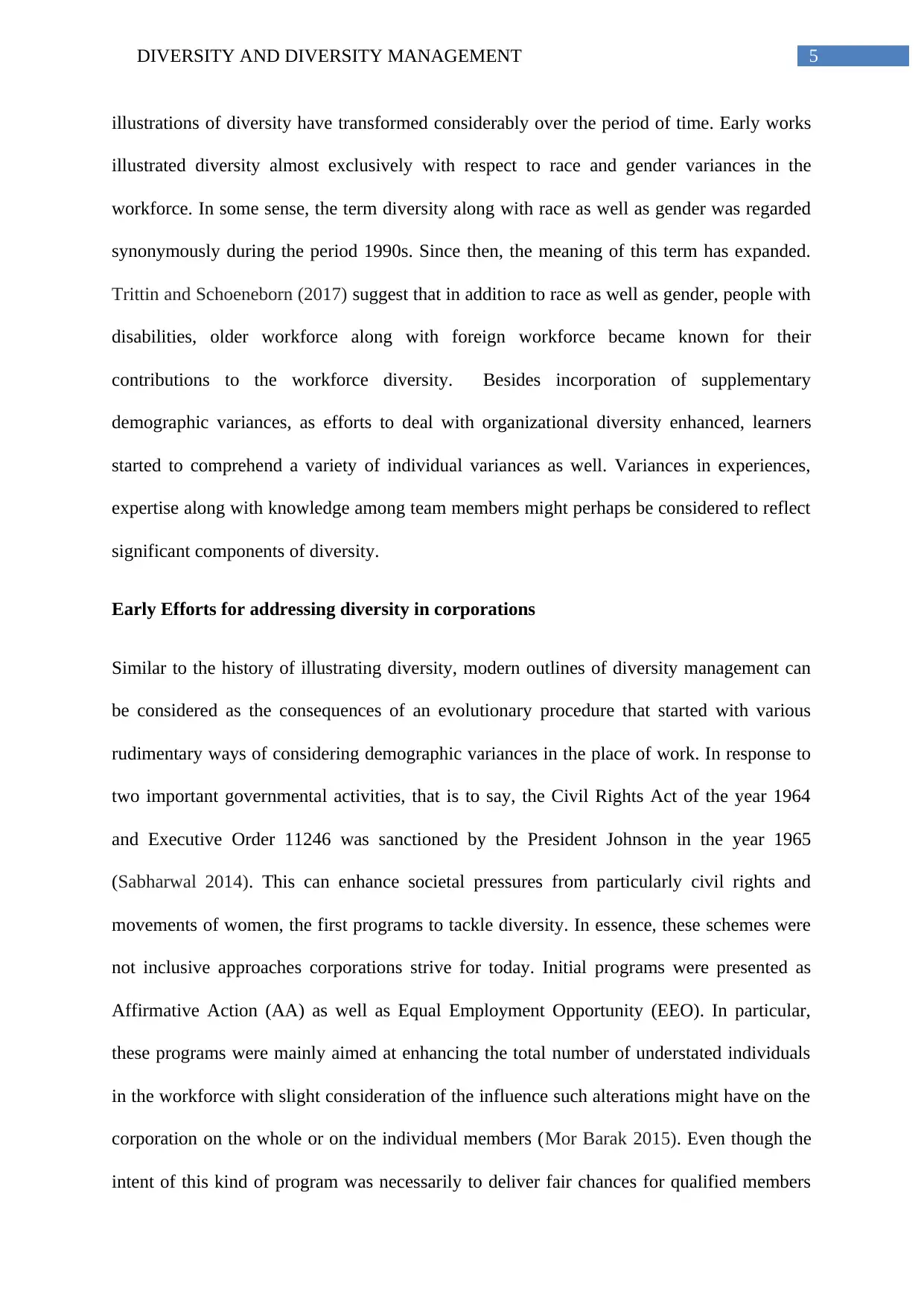
5DIVERSITY AND DIVERSITY MANAGEMENT
illustrations of diversity have transformed considerably over the period of time. Early works
illustrated diversity almost exclusively with respect to race and gender variances in the
workforce. In some sense, the term diversity along with race as well as gender was regarded
synonymously during the period 1990s. Since then, the meaning of this term has expanded.
Trittin and Schoeneborn (2017) suggest that in addition to race as well as gender, people with
disabilities, older workforce along with foreign workforce became known for their
contributions to the workforce diversity. Besides incorporation of supplementary
demographic variances, as efforts to deal with organizational diversity enhanced, learners
started to comprehend a variety of individual variances as well. Variances in experiences,
expertise along with knowledge among team members might perhaps be considered to reflect
significant components of diversity.
Early Efforts for addressing diversity in corporations
Similar to the history of illustrating diversity, modern outlines of diversity management can
be considered as the consequences of an evolutionary procedure that started with various
rudimentary ways of considering demographic variances in the place of work. In response to
two important governmental activities, that is to say, the Civil Rights Act of the year 1964
and Executive Order 11246 was sanctioned by the President Johnson in the year 1965
(Sabharwal 2014). This can enhance societal pressures from particularly civil rights and
movements of women, the first programs to tackle diversity. In essence, these schemes were
not inclusive approaches corporations strive for today. Initial programs were presented as
Affirmative Action (AA) as well as Equal Employment Opportunity (EEO). In particular,
these programs were mainly aimed at enhancing the total number of understated individuals
in the workforce with slight consideration of the influence such alterations might have on the
corporation on the whole or on the individual members (Mor Barak 2015). Even though the
intent of this kind of program was necessarily to deliver fair chances for qualified members
illustrations of diversity have transformed considerably over the period of time. Early works
illustrated diversity almost exclusively with respect to race and gender variances in the
workforce. In some sense, the term diversity along with race as well as gender was regarded
synonymously during the period 1990s. Since then, the meaning of this term has expanded.
Trittin and Schoeneborn (2017) suggest that in addition to race as well as gender, people with
disabilities, older workforce along with foreign workforce became known for their
contributions to the workforce diversity. Besides incorporation of supplementary
demographic variances, as efforts to deal with organizational diversity enhanced, learners
started to comprehend a variety of individual variances as well. Variances in experiences,
expertise along with knowledge among team members might perhaps be considered to reflect
significant components of diversity.
Early Efforts for addressing diversity in corporations
Similar to the history of illustrating diversity, modern outlines of diversity management can
be considered as the consequences of an evolutionary procedure that started with various
rudimentary ways of considering demographic variances in the place of work. In response to
two important governmental activities, that is to say, the Civil Rights Act of the year 1964
and Executive Order 11246 was sanctioned by the President Johnson in the year 1965
(Sabharwal 2014). This can enhance societal pressures from particularly civil rights and
movements of women, the first programs to tackle diversity. In essence, these schemes were
not inclusive approaches corporations strive for today. Initial programs were presented as
Affirmative Action (AA) as well as Equal Employment Opportunity (EEO). In particular,
these programs were mainly aimed at enhancing the total number of understated individuals
in the workforce with slight consideration of the influence such alterations might have on the
corporation on the whole or on the individual members (Mor Barak 2015). Even though the
intent of this kind of program was necessarily to deliver fair chances for qualified members
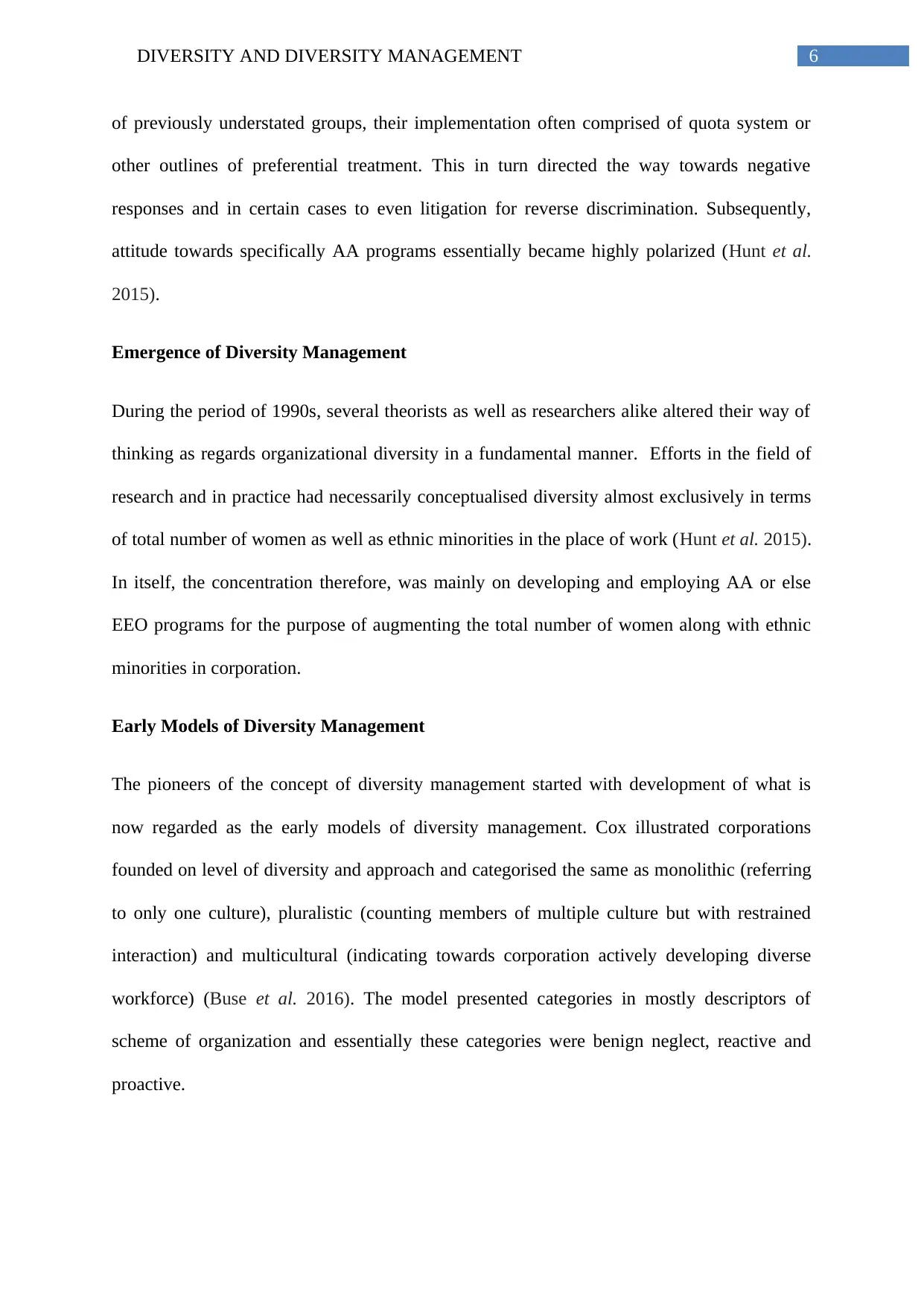
6DIVERSITY AND DIVERSITY MANAGEMENT
of previously understated groups, their implementation often comprised of quota system or
other outlines of preferential treatment. This in turn directed the way towards negative
responses and in certain cases to even litigation for reverse discrimination. Subsequently,
attitude towards specifically AA programs essentially became highly polarized (Hunt et al.
2015).
Emergence of Diversity Management
During the period of 1990s, several theorists as well as researchers alike altered their way of
thinking as regards organizational diversity in a fundamental manner. Efforts in the field of
research and in practice had necessarily conceptualised diversity almost exclusively in terms
of total number of women as well as ethnic minorities in the place of work (Hunt et al. 2015).
In itself, the concentration therefore, was mainly on developing and employing AA or else
EEO programs for the purpose of augmenting the total number of women along with ethnic
minorities in corporation.
Early Models of Diversity Management
The pioneers of the concept of diversity management started with development of what is
now regarded as the early models of diversity management. Cox illustrated corporations
founded on level of diversity and approach and categorised the same as monolithic (referring
to only one culture), pluralistic (counting members of multiple culture but with restrained
interaction) and multicultural (indicating towards corporation actively developing diverse
workforce) (Buse et al. 2016). The model presented categories in mostly descriptors of
scheme of organization and essentially these categories were benign neglect, reactive and
proactive.
of previously understated groups, their implementation often comprised of quota system or
other outlines of preferential treatment. This in turn directed the way towards negative
responses and in certain cases to even litigation for reverse discrimination. Subsequently,
attitude towards specifically AA programs essentially became highly polarized (Hunt et al.
2015).
Emergence of Diversity Management
During the period of 1990s, several theorists as well as researchers alike altered their way of
thinking as regards organizational diversity in a fundamental manner. Efforts in the field of
research and in practice had necessarily conceptualised diversity almost exclusively in terms
of total number of women as well as ethnic minorities in the place of work (Hunt et al. 2015).
In itself, the concentration therefore, was mainly on developing and employing AA or else
EEO programs for the purpose of augmenting the total number of women along with ethnic
minorities in corporation.
Early Models of Diversity Management
The pioneers of the concept of diversity management started with development of what is
now regarded as the early models of diversity management. Cox illustrated corporations
founded on level of diversity and approach and categorised the same as monolithic (referring
to only one culture), pluralistic (counting members of multiple culture but with restrained
interaction) and multicultural (indicating towards corporation actively developing diverse
workforce) (Buse et al. 2016). The model presented categories in mostly descriptors of
scheme of organization and essentially these categories were benign neglect, reactive and
proactive.
⊘ This is a preview!⊘
Do you want full access?
Subscribe today to unlock all pages.

Trusted by 1+ million students worldwide
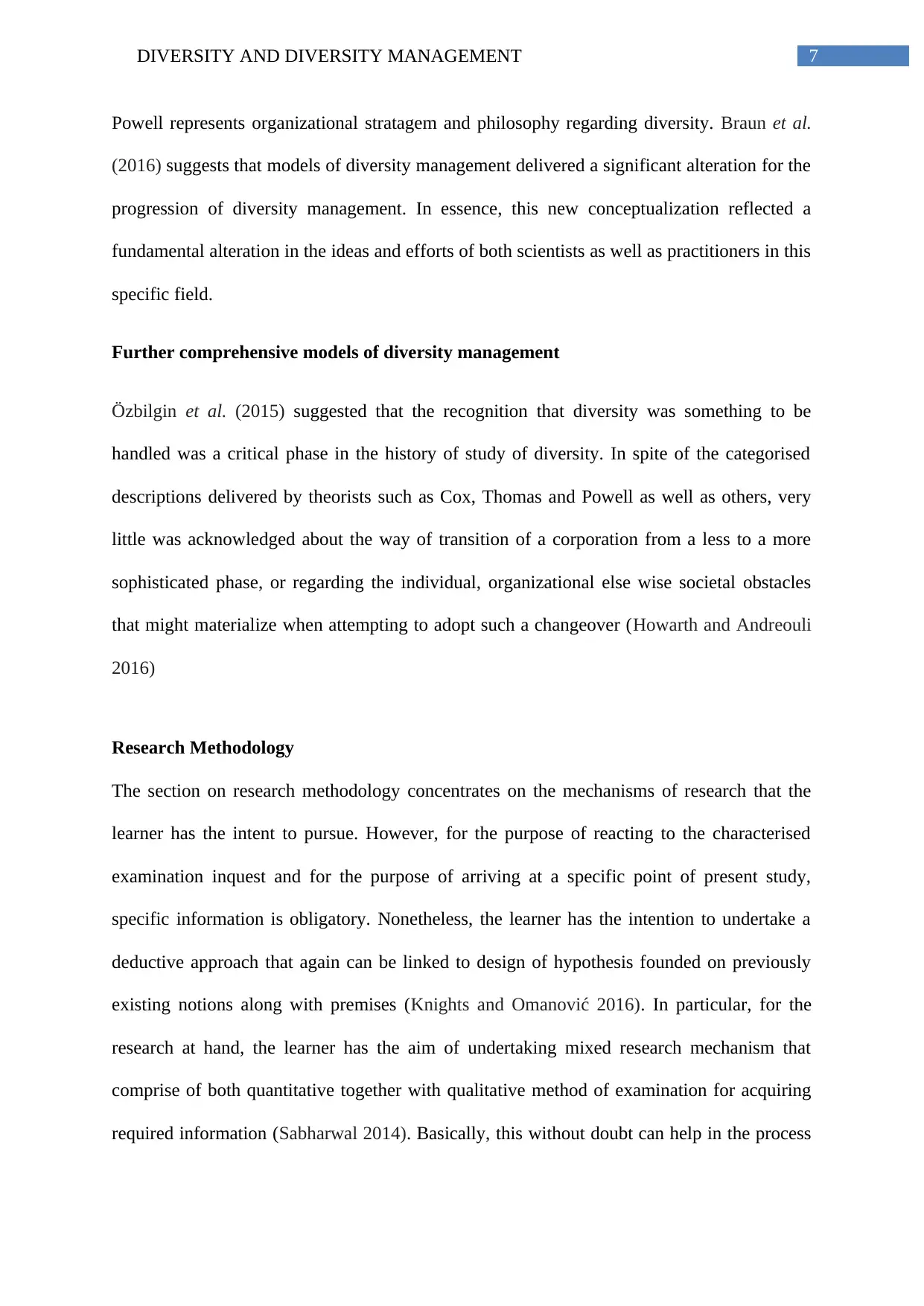
7DIVERSITY AND DIVERSITY MANAGEMENT
Powell represents organizational stratagem and philosophy regarding diversity. Braun et al.
(2016) suggests that models of diversity management delivered a significant alteration for the
progression of diversity management. In essence, this new conceptualization reflected a
fundamental alteration in the ideas and efforts of both scientists as well as practitioners in this
specific field.
Further comprehensive models of diversity management
Özbilgin et al. (2015) suggested that the recognition that diversity was something to be
handled was a critical phase in the history of study of diversity. In spite of the categorised
descriptions delivered by theorists such as Cox, Thomas and Powell as well as others, very
little was acknowledged about the way of transition of a corporation from a less to a more
sophisticated phase, or regarding the individual, organizational else wise societal obstacles
that might materialize when attempting to adopt such a changeover (Howarth and Andreouli
2016)
Research Methodology
The section on research methodology concentrates on the mechanisms of research that the
learner has the intent to pursue. However, for the purpose of reacting to the characterised
examination inquest and for the purpose of arriving at a specific point of present study,
specific information is obligatory. Nonetheless, the learner has the intention to undertake a
deductive approach that again can be linked to design of hypothesis founded on previously
existing notions along with premises (Knights and Omanović 2016). In particular, for the
research at hand, the learner has the aim of undertaking mixed research mechanism that
comprise of both quantitative together with qualitative method of examination for acquiring
required information (Sabharwal 2014). Basically, this without doubt can help in the process
Powell represents organizational stratagem and philosophy regarding diversity. Braun et al.
(2016) suggests that models of diversity management delivered a significant alteration for the
progression of diversity management. In essence, this new conceptualization reflected a
fundamental alteration in the ideas and efforts of both scientists as well as practitioners in this
specific field.
Further comprehensive models of diversity management
Özbilgin et al. (2015) suggested that the recognition that diversity was something to be
handled was a critical phase in the history of study of diversity. In spite of the categorised
descriptions delivered by theorists such as Cox, Thomas and Powell as well as others, very
little was acknowledged about the way of transition of a corporation from a less to a more
sophisticated phase, or regarding the individual, organizational else wise societal obstacles
that might materialize when attempting to adopt such a changeover (Howarth and Andreouli
2016)
Research Methodology
The section on research methodology concentrates on the mechanisms of research that the
learner has the intent to pursue. However, for the purpose of reacting to the characterised
examination inquest and for the purpose of arriving at a specific point of present study,
specific information is obligatory. Nonetheless, the learner has the intention to undertake a
deductive approach that again can be linked to design of hypothesis founded on previously
existing notions along with premises (Knights and Omanović 2016). In particular, for the
research at hand, the learner has the aim of undertaking mixed research mechanism that
comprise of both quantitative together with qualitative method of examination for acquiring
required information (Sabharwal 2014). Basically, this without doubt can help in the process
Paraphrase This Document
Need a fresh take? Get an instant paraphrase of this document with our AI Paraphraser
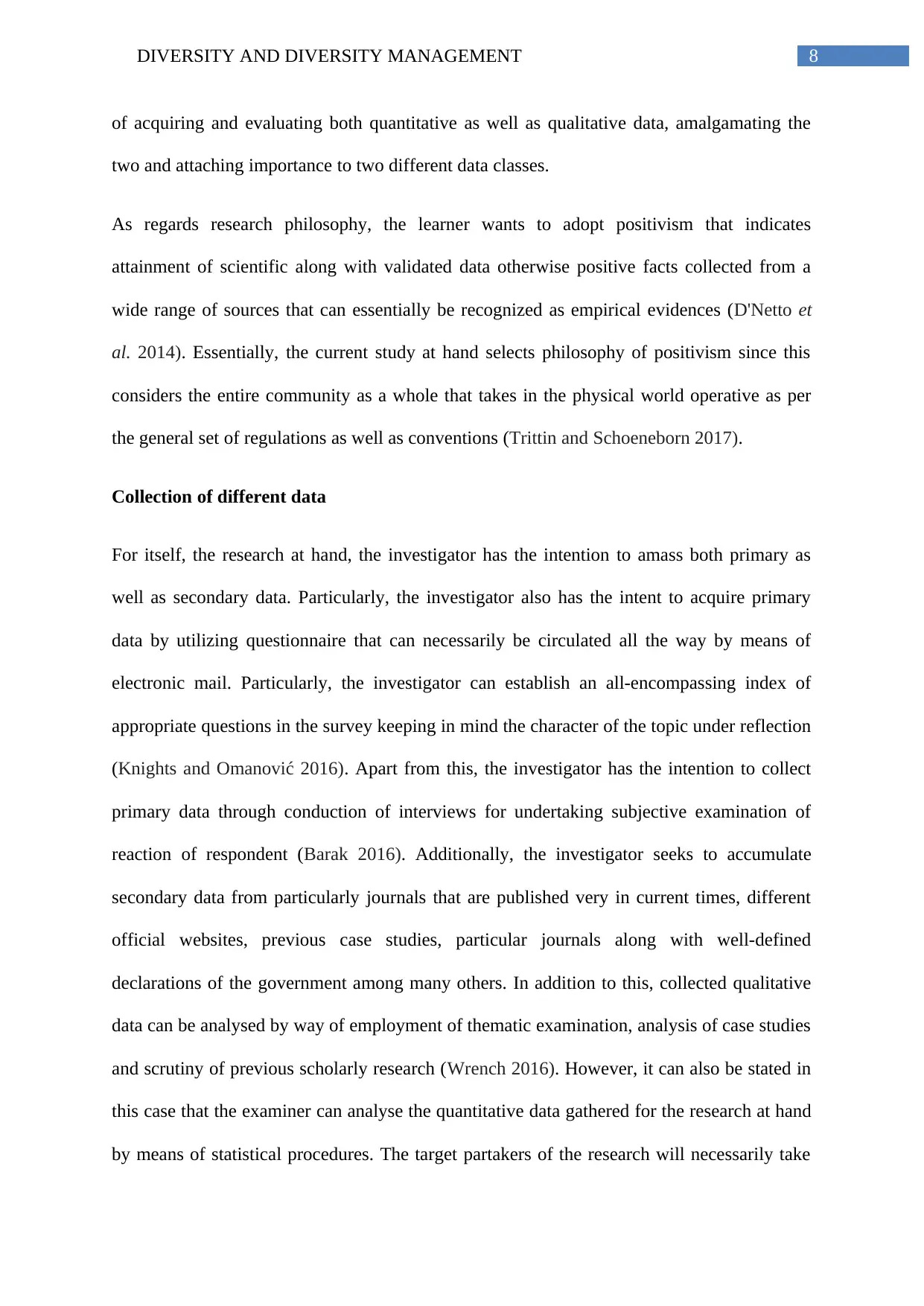
8DIVERSITY AND DIVERSITY MANAGEMENT
of acquiring and evaluating both quantitative as well as qualitative data, amalgamating the
two and attaching importance to two different data classes.
As regards research philosophy, the learner wants to adopt positivism that indicates
attainment of scientific along with validated data otherwise positive facts collected from a
wide range of sources that can essentially be recognized as empirical evidences (D'Netto et
al. 2014). Essentially, the current study at hand selects philosophy of positivism since this
considers the entire community as a whole that takes in the physical world operative as per
the general set of regulations as well as conventions (Trittin and Schoeneborn 2017).
Collection of different data
For itself, the research at hand, the investigator has the intention to amass both primary as
well as secondary data. Particularly, the investigator also has the intent to acquire primary
data by utilizing questionnaire that can necessarily be circulated all the way by means of
electronic mail. Particularly, the investigator can establish an all-encompassing index of
appropriate questions in the survey keeping in mind the character of the topic under reflection
(Knights and Omanović 2016). Apart from this, the investigator has the intention to collect
primary data through conduction of interviews for undertaking subjective examination of
reaction of respondent (Barak 2016). Additionally, the investigator seeks to accumulate
secondary data from particularly journals that are published very in current times, different
official websites, previous case studies, particular journals along with well-defined
declarations of the government among many others. In addition to this, collected qualitative
data can be analysed by way of employment of thematic examination, analysis of case studies
and scrutiny of previous scholarly research (Wrench 2016). However, it can also be stated in
this case that the examiner can analyse the quantitative data gathered for the research at hand
by means of statistical procedures. The target partakers of the research will necessarily take
of acquiring and evaluating both quantitative as well as qualitative data, amalgamating the
two and attaching importance to two different data classes.
As regards research philosophy, the learner wants to adopt positivism that indicates
attainment of scientific along with validated data otherwise positive facts collected from a
wide range of sources that can essentially be recognized as empirical evidences (D'Netto et
al. 2014). Essentially, the current study at hand selects philosophy of positivism since this
considers the entire community as a whole that takes in the physical world operative as per
the general set of regulations as well as conventions (Trittin and Schoeneborn 2017).
Collection of different data
For itself, the research at hand, the investigator has the intention to amass both primary as
well as secondary data. Particularly, the investigator also has the intent to acquire primary
data by utilizing questionnaire that can necessarily be circulated all the way by means of
electronic mail. Particularly, the investigator can establish an all-encompassing index of
appropriate questions in the survey keeping in mind the character of the topic under reflection
(Knights and Omanović 2016). Apart from this, the investigator has the intention to collect
primary data through conduction of interviews for undertaking subjective examination of
reaction of respondent (Barak 2016). Additionally, the investigator seeks to accumulate
secondary data from particularly journals that are published very in current times, different
official websites, previous case studies, particular journals along with well-defined
declarations of the government among many others. In addition to this, collected qualitative
data can be analysed by way of employment of thematic examination, analysis of case studies
and scrutiny of previous scholarly research (Wrench 2016). However, it can also be stated in
this case that the examiner can analyse the quantitative data gathered for the research at hand
by means of statistical procedures. The target partakers of the research will necessarily take
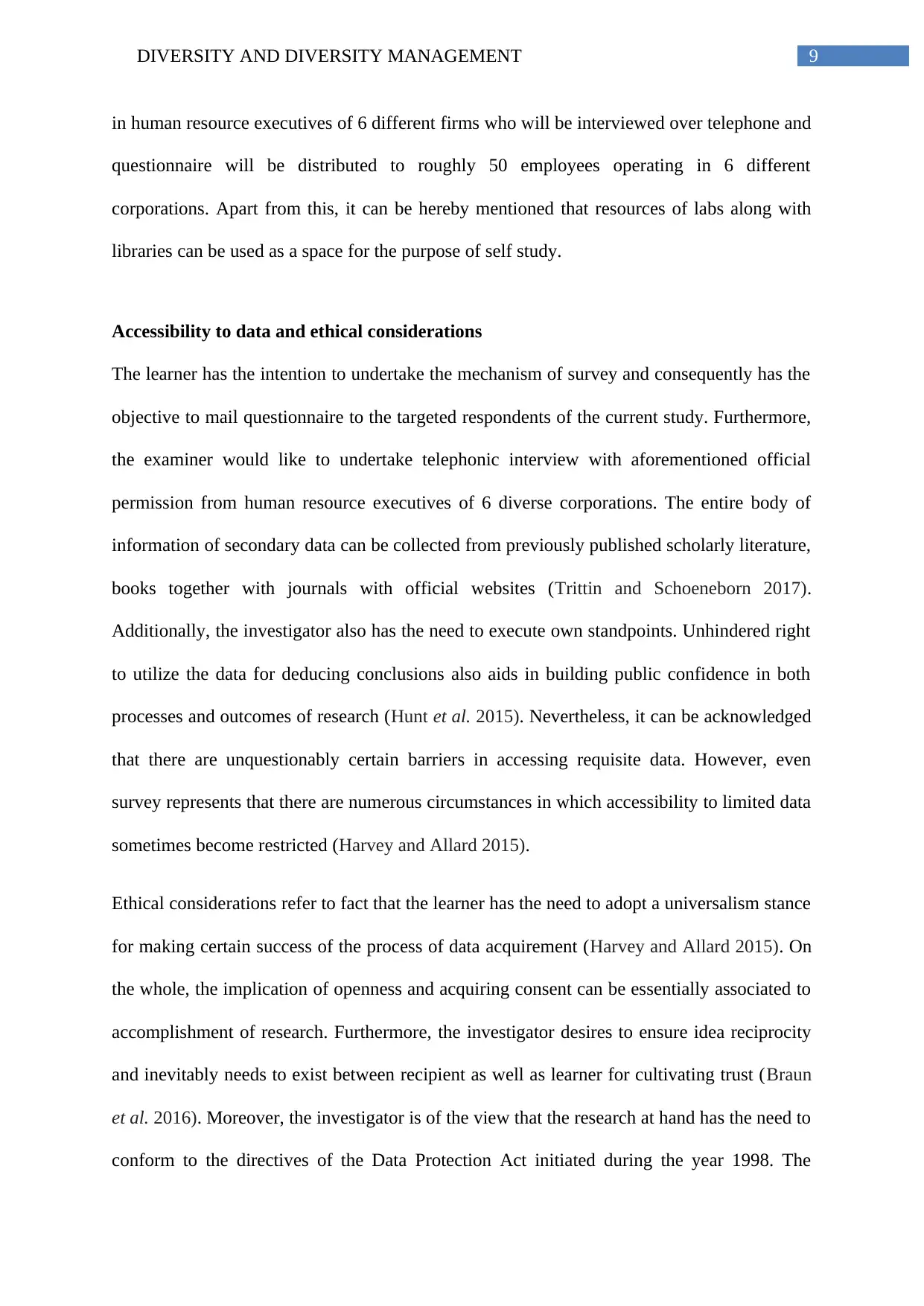
9DIVERSITY AND DIVERSITY MANAGEMENT
in human resource executives of 6 different firms who will be interviewed over telephone and
questionnaire will be distributed to roughly 50 employees operating in 6 different
corporations. Apart from this, it can be hereby mentioned that resources of labs along with
libraries can be used as a space for the purpose of self study.
Accessibility to data and ethical considerations
The learner has the intention to undertake the mechanism of survey and consequently has the
objective to mail questionnaire to the targeted respondents of the current study. Furthermore,
the examiner would like to undertake telephonic interview with aforementioned official
permission from human resource executives of 6 diverse corporations. The entire body of
information of secondary data can be collected from previously published scholarly literature,
books together with journals with official websites (Trittin and Schoeneborn 2017).
Additionally, the investigator also has the need to execute own standpoints. Unhindered right
to utilize the data for deducing conclusions also aids in building public confidence in both
processes and outcomes of research (Hunt et al. 2015). Nevertheless, it can be acknowledged
that there are unquestionably certain barriers in accessing requisite data. However, even
survey represents that there are numerous circumstances in which accessibility to limited data
sometimes become restricted (Harvey and Allard 2015).
Ethical considerations refer to fact that the learner has the need to adopt a universalism stance
for making certain success of the process of data acquirement (Harvey and Allard 2015). On
the whole, the implication of openness and acquiring consent can be essentially associated to
accomplishment of research. Furthermore, the investigator desires to ensure idea reciprocity
and inevitably needs to exist between recipient as well as learner for cultivating trust (Braun
et al. 2016). Moreover, the investigator is of the view that the research at hand has the need to
conform to the directives of the Data Protection Act initiated during the year 1998. The
in human resource executives of 6 different firms who will be interviewed over telephone and
questionnaire will be distributed to roughly 50 employees operating in 6 different
corporations. Apart from this, it can be hereby mentioned that resources of labs along with
libraries can be used as a space for the purpose of self study.
Accessibility to data and ethical considerations
The learner has the intention to undertake the mechanism of survey and consequently has the
objective to mail questionnaire to the targeted respondents of the current study. Furthermore,
the examiner would like to undertake telephonic interview with aforementioned official
permission from human resource executives of 6 diverse corporations. The entire body of
information of secondary data can be collected from previously published scholarly literature,
books together with journals with official websites (Trittin and Schoeneborn 2017).
Additionally, the investigator also has the need to execute own standpoints. Unhindered right
to utilize the data for deducing conclusions also aids in building public confidence in both
processes and outcomes of research (Hunt et al. 2015). Nevertheless, it can be acknowledged
that there are unquestionably certain barriers in accessing requisite data. However, even
survey represents that there are numerous circumstances in which accessibility to limited data
sometimes become restricted (Harvey and Allard 2015).
Ethical considerations refer to fact that the learner has the need to adopt a universalism stance
for making certain success of the process of data acquirement (Harvey and Allard 2015). On
the whole, the implication of openness and acquiring consent can be essentially associated to
accomplishment of research. Furthermore, the investigator desires to ensure idea reciprocity
and inevitably needs to exist between recipient as well as learner for cultivating trust (Braun
et al. 2016). Moreover, the investigator is of the view that the research at hand has the need to
conform to the directives of the Data Protection Act initiated during the year 1998. The
⊘ This is a preview!⊘
Do you want full access?
Subscribe today to unlock all pages.

Trusted by 1+ million students worldwide
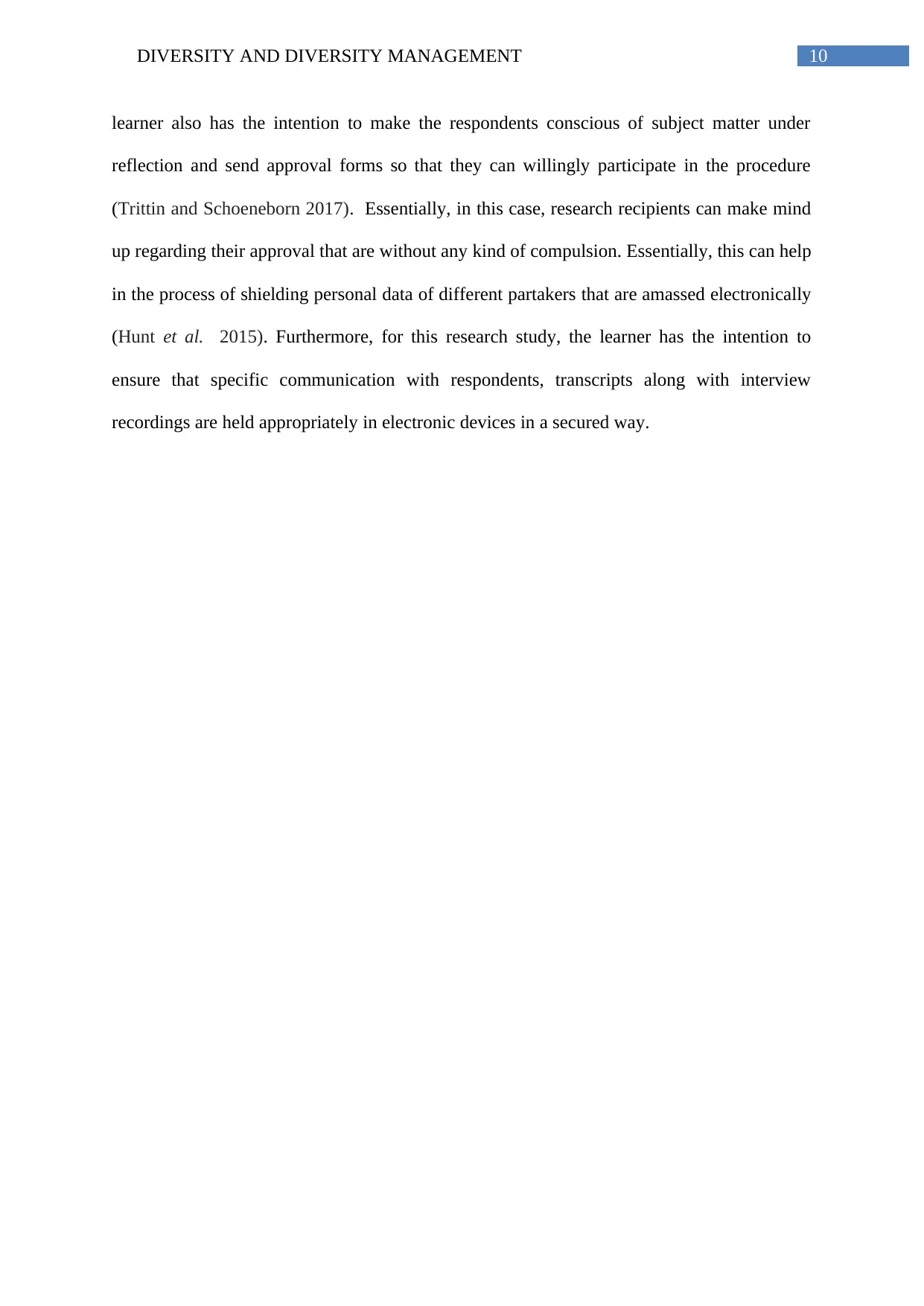
10DIVERSITY AND DIVERSITY MANAGEMENT
learner also has the intention to make the respondents conscious of subject matter under
reflection and send approval forms so that they can willingly participate in the procedure
(Trittin and Schoeneborn 2017). Essentially, in this case, research recipients can make mind
up regarding their approval that are without any kind of compulsion. Essentially, this can help
in the process of shielding personal data of different partakers that are amassed electronically
(Hunt et al. 2015). Furthermore, for this research study, the learner has the intention to
ensure that specific communication with respondents, transcripts along with interview
recordings are held appropriately in electronic devices in a secured way.
learner also has the intention to make the respondents conscious of subject matter under
reflection and send approval forms so that they can willingly participate in the procedure
(Trittin and Schoeneborn 2017). Essentially, in this case, research recipients can make mind
up regarding their approval that are without any kind of compulsion. Essentially, this can help
in the process of shielding personal data of different partakers that are amassed electronically
(Hunt et al. 2015). Furthermore, for this research study, the learner has the intention to
ensure that specific communication with respondents, transcripts along with interview
recordings are held appropriately in electronic devices in a secured way.
Paraphrase This Document
Need a fresh take? Get an instant paraphrase of this document with our AI Paraphraser
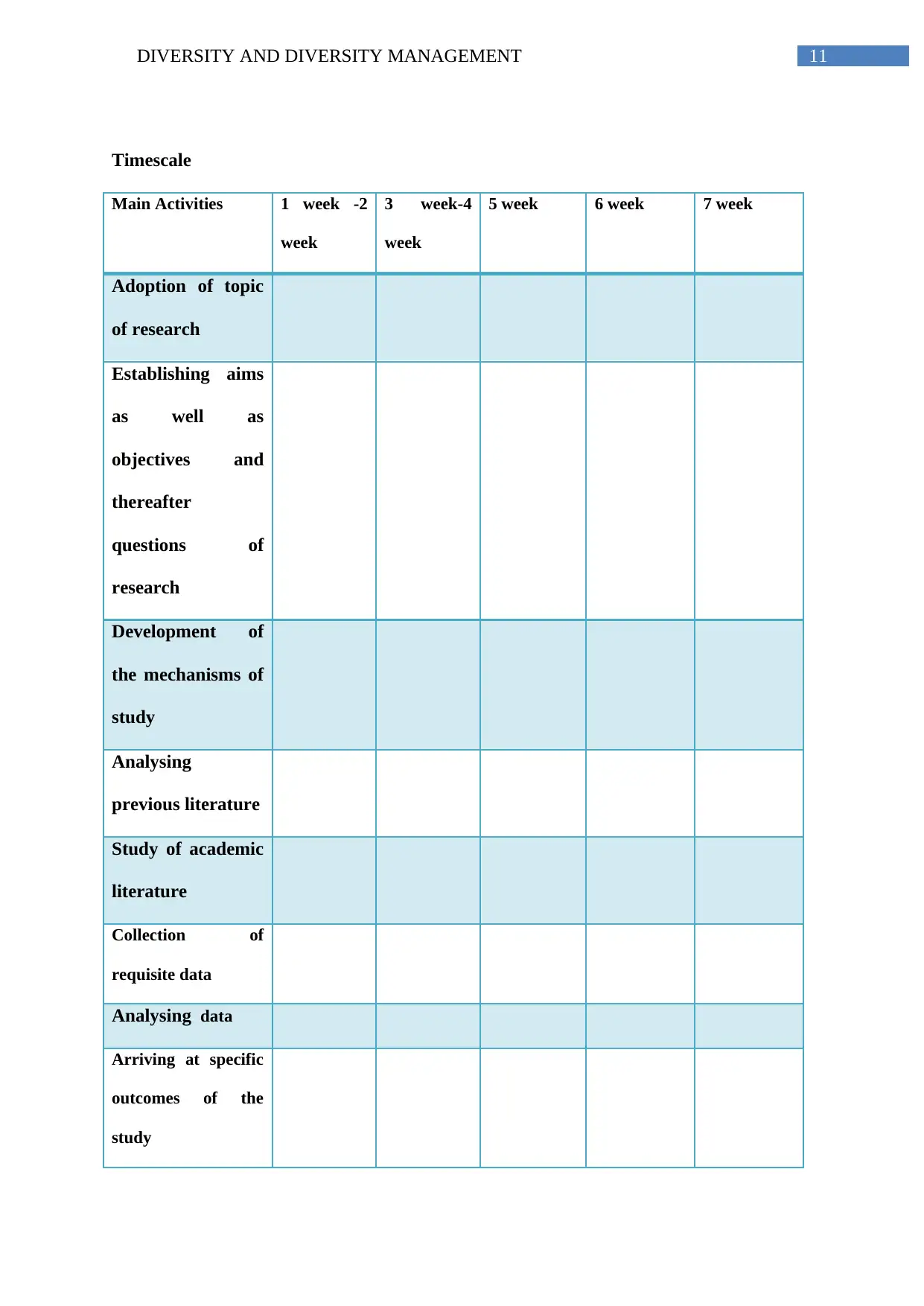
11DIVERSITY AND DIVERSITY MANAGEMENT
Timescale
Main Activities 1 week -2
week
3 week-4
week
5 week 6 week 7 week
Adoption of topic
of research
Establishing aims
as well as
objectives and
thereafter
questions of
research
Development of
the mechanisms of
study
Analysing
previous literature
Study of academic
literature
Collection of
requisite data
Analysing data
Arriving at specific
outcomes of the
study
Timescale
Main Activities 1 week -2
week
3 week-4
week
5 week 6 week 7 week
Adoption of topic
of research
Establishing aims
as well as
objectives and
thereafter
questions of
research
Development of
the mechanisms of
study
Analysing
previous literature
Study of academic
literature
Collection of
requisite data
Analysing data
Arriving at specific
outcomes of the
study
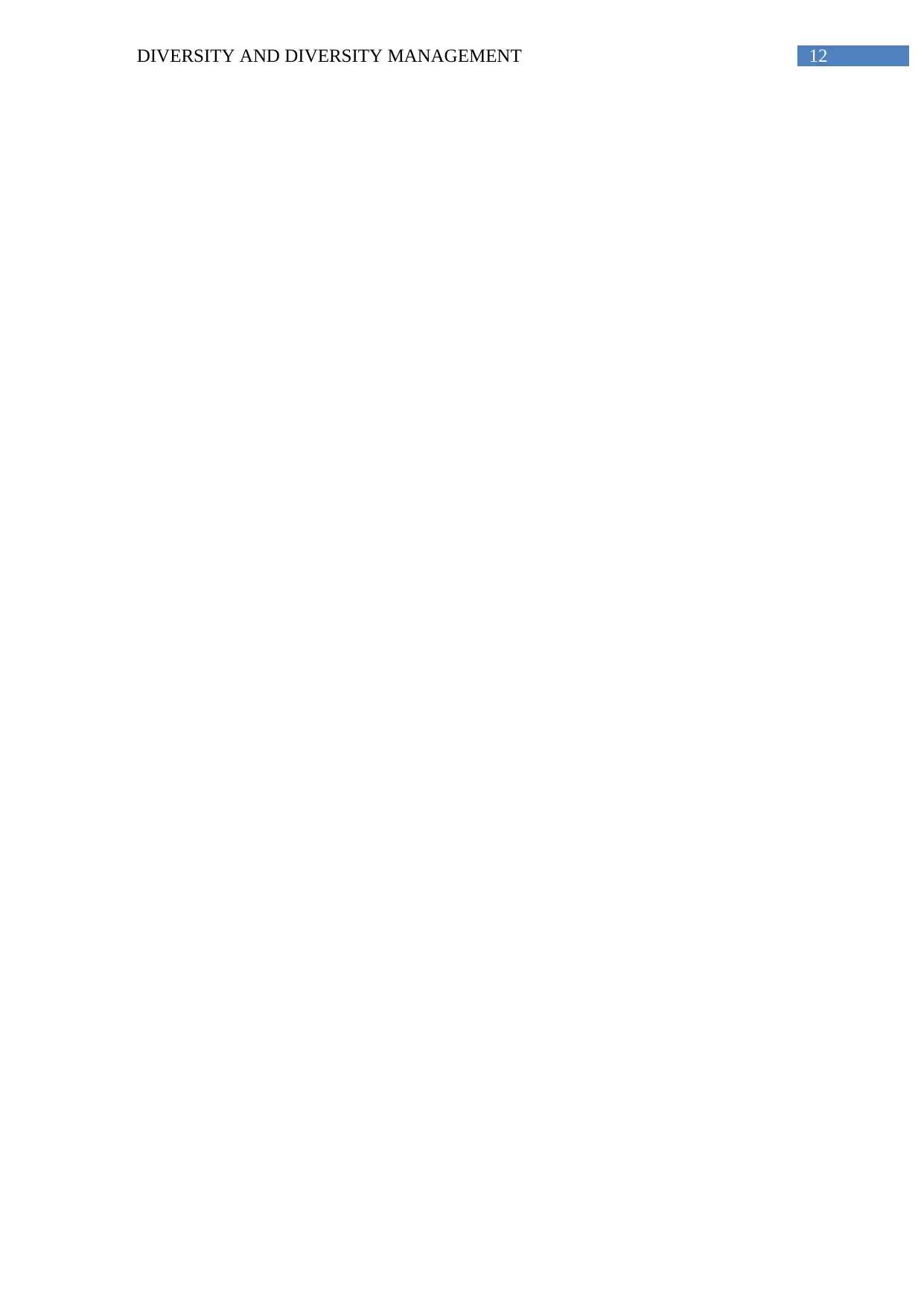
12DIVERSITY AND DIVERSITY MANAGEMENT
⊘ This is a preview!⊘
Do you want full access?
Subscribe today to unlock all pages.

Trusted by 1+ million students worldwide
1 out of 13
Related Documents
Your All-in-One AI-Powered Toolkit for Academic Success.
+13062052269
info@desklib.com
Available 24*7 on WhatsApp / Email
![[object Object]](/_next/static/media/star-bottom.7253800d.svg)
Unlock your academic potential
Copyright © 2020–2025 A2Z Services. All Rights Reserved. Developed and managed by ZUCOL.




